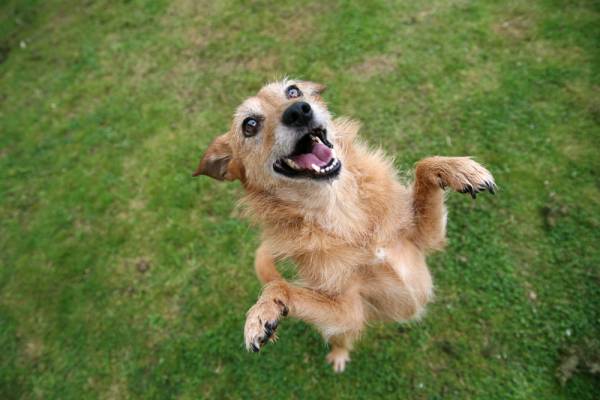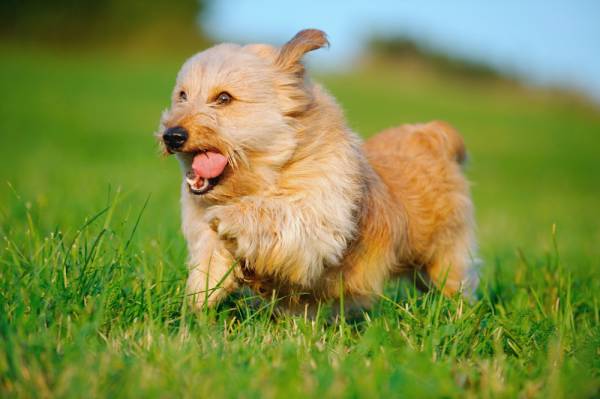Recently when some friends of mine went out of town, I took care of their two dogs. I love dogs and have always been around them, but I’m not often a primary canine caretaker over and above taking them on the occasional walk or sneaking them food from my plate. The changes I found it necessary to make to my normal habits while caring for them got me thinking about what doggies can teach us about athletics and health.
Professional dog trainer Chrissy Linzy agrees with me. Chrissy was a member of the Association of Pet Dog Trainers and a Certified Pet Dog Trainer for a number of years, and as you might imagine, she has lovely, obedient dogs herself. With Chrissy as a reference, I came up with eight ways dogs and caring for dogs can help us maximize our athletic and human potential.
1. Establish and maintain a routine.
When caring for my friends’ dogs, it became clear they thrive on predictability. They expect to eat at certain times, they want to walk the same way to the dog park every time, and they need to have their doggie beds and squeaky toys nearby to be able to sleep. Routine is important for us people, too. If we schedule our workout times, we’re more likely to work out. If we plan our meals, they are more likely to be healthy ones. This is something everyone knows, but interacting with dogs drives home how important these routines are, and how not following them can spell the difference between a happy doggie and a whining one, or a clean rug and a call to the professional carpet shampooer.
2. Routines are meant to be altered.
On the way to the dog park, I always hung on tightly to the dogs’ leashes, because I never knew what was going to arise that might cause them to want to either take off running or stop in their tracks. Frequently it was a squirrel. Sometimes it was a bird. And sometimes it was a random item in the grass. The point is, sometimes during the routine walk to the park, we would all have to modify and go with the flow if something unexpected arose. Obviously, we humans would do well to demonstrate similar resilience; if someone else is using the kettlebells or we run out of an important ingredient, a little flexibility can help us make changes on the fly that will keep us from deciding not to work out after all or to order pizza instead.
3. Playing is important when trying to learn something new.
 As Chrissy has observed, “If you’ve ever owned a dog, you probably taught him a few tricks. Tricks were fun to teach him, but learning to stay was a battle.” Teaching a dog to stay seems like a chore and is approached that way. “People forget that all of the training we do with our dogs can be fun.” If we teach dogs to sit or heel with the same fun attitude we use when we teach them to roll over, they learn faster. “We get to reward the dog more often. Everyone is having fun, so everyone is winning. Using games to teach these exercises means that you get to teach the important things and still have a good time doing it.” Doesn’t that sound fun and effective for your own training as well?
As Chrissy has observed, “If you’ve ever owned a dog, you probably taught him a few tricks. Tricks were fun to teach him, but learning to stay was a battle.” Teaching a dog to stay seems like a chore and is approached that way. “People forget that all of the training we do with our dogs can be fun.” If we teach dogs to sit or heel with the same fun attitude we use when we teach them to roll over, they learn faster. “We get to reward the dog more often. Everyone is having fun, so everyone is winning. Using games to teach these exercises means that you get to teach the important things and still have a good time doing it.” Doesn’t that sound fun and effective for your own training as well?
4. Love yourself the way your dog loves you: unconditionally.
You may be familiar with the research suggesting that we feel more relaxed and comfortable around our dogs than we do even among our loved ones. But not even the research captures how unfailingly wonderful it is simply to sit on the ground and immediately be accosted by furry bundles of love that just want to be near you, lean on you, lick your face, fight each other for a spot in your lap. The love of a dog can make you feel like the absolute best person on the face of the planet, a feeling that is sadly fleeting for many of us when we pursue our athletic goals. So the next time you think about beating yourself up because you missed a lift or got choked out, remember how a dog loves you – unconditionally – and try to help him with that.
5. Be clear about what’s truly important.
How many of us have pulled on our dog’s leash only to have her resist because she has her snout buried in something important on the sidewalk or near a mailbox post? Humans could learn something from this. Dogs put their paws down for the important things, like thoroughly investigating the scent of another dog’s pee, a pile of rabbit poop, a mouthful of grass. They are easygoing for the most part, but they know what’s non-negotiable, and they do not hesitate to let you know that they won’t compromise on those important things. As humans, it would behoove us to identify what constitutes our rabbit poop and act accordingly. What are your non-negotiables when it comes to your training, your health, and your life? Family time? Eight hours of sleep? Articulate and enforce those things.
6. Assume the best of others.
 Many doggies, especially pups, approach strangers with absolute purity of heart. They assume everyone is a treat-carrying, Frisbee-throwing angel from heaven who lives to scratch their bellies. Of course, not everyone is like this, but why do you think so many people like dogs? Because they are purely, unabashedly happy to see you. As a firm believer that we reap what we sow energetically, I try to be upbeat in my dealings with everyone and to believe that my interaction with you is going to be great. If someone I interact with is are in a bad mood, maybe I can change the dynamic so they’re at least pleasant with me. And if they are going to be helping me with a workout, I want them to be in as good a mood as possible. This is consistent with Chrissy’s experience with dogs. “One of the most important things I’ve noticed when training dogs is that it’s critical for the trainer to be in a good mood.” What’s good for the pooch is good for the gander.
Many doggies, especially pups, approach strangers with absolute purity of heart. They assume everyone is a treat-carrying, Frisbee-throwing angel from heaven who lives to scratch their bellies. Of course, not everyone is like this, but why do you think so many people like dogs? Because they are purely, unabashedly happy to see you. As a firm believer that we reap what we sow energetically, I try to be upbeat in my dealings with everyone and to believe that my interaction with you is going to be great. If someone I interact with is are in a bad mood, maybe I can change the dynamic so they’re at least pleasant with me. And if they are going to be helping me with a workout, I want them to be in as good a mood as possible. This is consistent with Chrissy’s experience with dogs. “One of the most important things I’ve noticed when training dogs is that it’s critical for the trainer to be in a good mood.” What’s good for the pooch is good for the gander.
7. Rein in your multitasking.
When I was taking care of my friends’ dogs, I swear to Fido they wanted me to watch them while they played. The first day I set them loose in the dog park, I assumed they’d start running around and completely ignoring me, but how wrong I was. I pulled out my phone and did a little texting and Internet searching, and then after a minute or two, I noticed things were oddly quiet. When I looked up, I saw both dogs staring intently at me, as if waiting for me to notice what they were doing. Once they had my full attention and I put my phone away and said, “Okay, guys!” they took off like rockets, running around, but stopping periodically to make sure I was present and accounted for. I found I really had to concentrate on one thing – the dogs – and I found myself enjoying it immensely. And this translates into our athletic and health endeavors because if we want to learn and progress, we must focus and put in the time.
8. Stop overthinking things.
 There’s a pond at the dog park I took my wards to. When I threw sticks into the water for them to retrieve, they barreled right in with nary a second thought. Nary a first thought, if the truth were known. Of course, they’ve been to this park before, so they knew the depth of the water and the like, but the point is they didn’t get wet slowly. They literally dove in. How many times in your own training has your brain turned out to be your nemesis? You think for a split second too long, and that second is enough to sow the seeds of doubt and cause you to mistime the takedown or mess up the throw. The brain is important, of course, but too much thinking can lead to “dare I eat a peach” syndrome. Eat the peach, and do it fast before the dog gets it.
There’s a pond at the dog park I took my wards to. When I threw sticks into the water for them to retrieve, they barreled right in with nary a second thought. Nary a first thought, if the truth were known. Of course, they’ve been to this park before, so they knew the depth of the water and the like, but the point is they didn’t get wet slowly. They literally dove in. How many times in your own training has your brain turned out to be your nemesis? You think for a split second too long, and that second is enough to sow the seeds of doubt and cause you to mistime the takedown or mess up the throw. The brain is important, of course, but too much thinking can lead to “dare I eat a peach” syndrome. Eat the peach, and do it fast before the dog gets it.
In Brazilian jiu jitsu, the conventional wisdom is that you can learn something from anyone, no matter the level of experience. After taking care of my canine friends recently, I have extended the definition of “anyone” to include even “sentient beings who like to chew on sticks and sniff crotches.” (Okay, that could apply to lots of sentient beings. But you get the point.) Are you a dog lover? What have you learned from your canine friends that relates to life, health, and athletics? Post your observations to comments.
Photos courtesy of Shutterstock.






